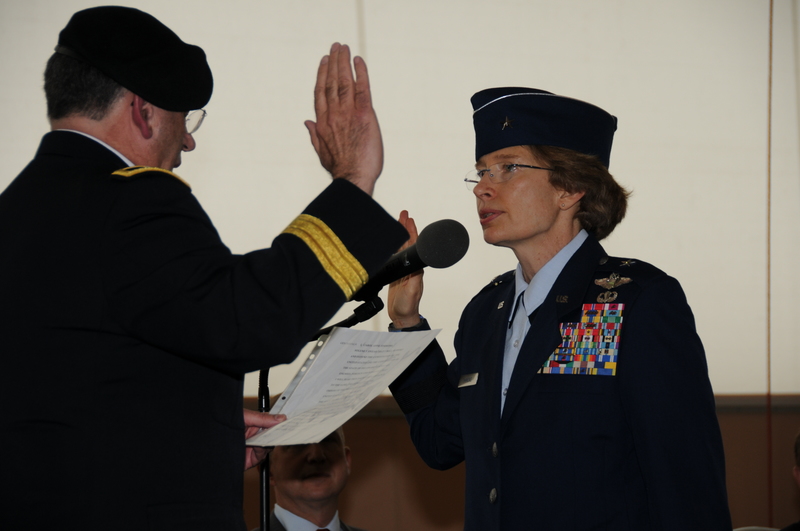Gen. Carol A. Timmons’ life defined by historic moments
A series of defining moments has helped write the fascinating story of Carol A. Timmons’ life. One of the first female combat pilots and the first brigadier general ever in the Delaware Air National Guard, her life is one best defined by historic moments.
Like a star athlete, the pilot’s statistics would qualify her for the Hall of Fame, flying 9,000 civilian hours and 5,000 military hours. And, in fact, the Rehoboth Beach resident was inducted into the Delaware Women’s Hall of Fame in 2004 and the Delaware Aviation Hall of Fame in 2007.
Yet, those hours are only one chapter. As a trendsetter and barrier-breaker in a male-dominated field, she was one of the first female pilots to fly in combat. She has never let gender get in her way to do the one thing she has always wanted to do – fly jets.
For her efforts in 2008, commanding a combat deployment to Afghanistan, she received the Bronze Star. She directed 700 troops through 6,700 air support, air drops, medical evacuations and search-and-rescue missions, handling millions of pounds of cargo and munitions, thousands of passengers and hundreds of medical patients.
The unit’s first female pilot has flown missions in the C-130 in support of Bosnia, Kosovo and other global operations. In 2003, her unit was activated for Operation Iraqi Freedom, an activation that lasted almost three years.
“My favorite place is the left seat of a C-130,” she says.
While flying in and out of Baghdad, she realized she was in the right place. “I was doing what I was told I couldn’t do,” she said. She has carried out more than 100 combat flying missions.
“It was so tough. I never thought I would see a change in my career because the barriers to women were that strong,” she said.
At 53, she is the first brigadier general in the history of the Delaware Air National Guard. She received her general’s stars in a May 14 ceremony in front of 500 people. It was a long journey from the single enlisted airman’s stripe she received in early 1977.
As defining as the moments are, there is still another on a day that will live in her mind forever.
A connection to 9/11
On Sept. 11, 2001, Timmons was co-pilot of United Airlines Flight 23 on the tarmac at John F. Kennedy Airport. Prepared to take off, the plane was among all other U.S. flights ordered to return to the gate.
Although never officially confirmed by government officials, author Lynn Spencer claims Flight 23 was the fifth plane in al-Qaeda’s hijack plans. At least three Arab passengers left the plane once it reached the gate. There were reports of box cutters and al-Qaeda documents left in their carry-on luggage.
Spencer included her findings on Flight 23 in the 2008 book, “Touching History: The Untold Story of the Drama that Unfolded in the Skies Over America 9/11.”
“Officially, I can’t talk about that,” Timmons said. “What I can say is that we were notified to barricade the door and return to the gate.”
Timmons said the FBI interviewed the crew, but no one was told any information after the interviews. “The mystery of Flight 23 is still out there because there has never been any confirmation,” she said.
There was no mention of Flight 23 in the official 9/11 Commission Report.
The day was a sad one for Timmons because she had worked with the pilots, crew and flight attendants on hijacked United Airlines Flight 93 that took off from Newark International Airport and eventually crashed in a field near Shanksville, Pa.
“It could have been any of us; I knew them all and will never forget them,” she said.
Her dream has been to fly jets
She was 5 years old when she decided she wanted to be a pilot, but growing up near New Castle, she didn’t have much opportunity to get close to a plane – even though the New Castle County Airport, home to the Air Guard – was not that far away. That would eventually change as helicopters and airplanes would become an integral part of her life.
During her childhood, she was interested in sports and helped with family chores as the oldest of five brothers and sisters.
But after graduation in 1977 from William Penn High School, she joined the Delaware Air National Guard and was able to fly in her first C-130 during summer camp in Savannah, Ga. She was hooked.
It was about that time that the first women were allowed in Air Force flight training classes. But because the C-130 was considered a combat-mission plane, she was not allowed to fly it.
Undeterred, in 1980 she joined the Army National Guard where she was trained to fly helicopters and earned a bachelor’s degree in aviation management at Wilmington College. She took her first solo in a UH-1 Huey helicopter, not an airplane. Still determined to realize her childhood dream, she switched to the Air Force Reserves where she could fly noncombat missions on C-141 transports. During Desert Storm in the early 1990s, then Capt. Timmons flew her first combat support missions in and out of the Middle East.
It wasn’t long after flying in support of Operation Desert Storm that she came full circle and rejoined the Delaware Air National Guard’s 166th operations group to fly C-130s, the plane she sought to fly for more than 15 years.
Women in combat
Federal laws were changed in the early 1990s to allow service women to take a more active role in combat zones. Women were permitted to fly combat missions in 1992, board ships in 1993 and be assigned to some ground units in 1994.
Timmons said several factors put pressure on policy makers to make changes, including a need to attract women in an all-volunteer armed services, a growing need to recognize women in the military who were already flying every plane men were flying and a blurring of the front lines starting with Operation Desert Storm.
Ironically, the first women pilots to fly in World War II operated a ferrying service out of New Castle County Airport, the home of Delaware Air National Guard.
“I never dreamed I would fly in combat,” she said. “I never planned to be a colonel or commander either.”
She set a career goal of serving 20 years in the military, retiring and becoming a commercial pilot. That path changed somewhat. She is now entering her 34th year in the military, but still keeps her “day job” as a commercial pilot.
In 1987, Pan Am hired her as a flight engineer and when the company went out of business, United Airlines hired her in 1993 as a pilot. Today, she flies transcontinental flights out of JFK, LaGuardia and Newark.
In her current task as director of the Guard’s joint staff – Air Force and Army – she sees a lot less flying time, but she says that’s all right because younger pilots are coming up through the ranks.
She works 10 to 12 days a month for United and about eight days a month for the Delaware Air National Guard. But, she is constantly in contact with her unit via cell phone and internet. “I have the two best jobs in the world,” she said.























































